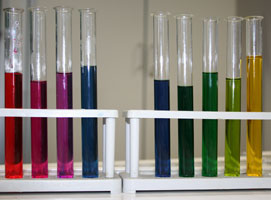What you need:
Pickled red cabbage
vinegar
Bicarbonate of soda
at least three containers, such as small glass jars or even test tubes
What to do:
• Remove the cabbage from the jar as you only need the fluid that was in the jar. Put aside for your Dad to eat later.
• Pour a little of the cabbage juice into each of your containers. Note the colour of the juice. Put one container with the juice in to one side.
• In another container add a small pinch of bicarbonate of soda to the juice. What happens?
• To a different container add a small amount of vinegar to the juice. What happens?
Why it works:
The colouring in the cabbage juice is an acid/alkaline indicator. When it is in an acid, such as vinegar, the juice turns red. When it is in an alkaline, such as bicarbonate of soda in turns blue-green. Are there any other substances that you could test? You could try lemon juice, washing up liquid and soap flakes, for example.







